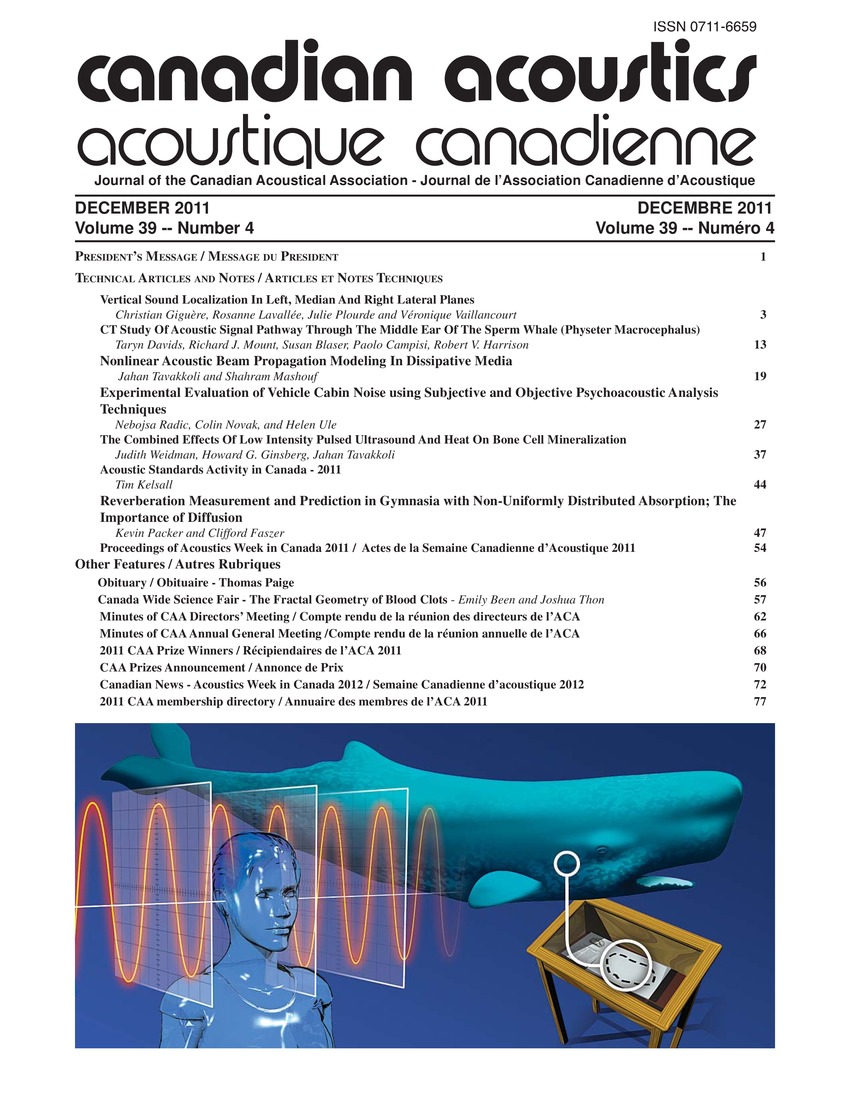Reverberation measurement and prediction in gymnasia with non-uniformly distributed absorption; The importance of diffusion
Keywords:
Acoustic fields, Architectural acoustics, Glass fibers, Plywood, Reverberation, Wood products, Architectural constraints, Diffuse sound fields, Fiberglass insulation, Performance verification, Room acoustics, Room size, Standing wave modesAbstract
As part of a performance verification exercise reverberation times (RT) were measured in several newly constructed school gymnasia, rectangular in plan with two variations in room size, all with similar finishes and constructions. Due to architectural constraints, the rooms have acoustically hard finishes below a height of 3 m. The room finishes are primarily acoustically reflective with the exception of continuous bands of absorptive upper wall paneling around the full perimeter of the rooms (exposed unpainted Tectum over mineral fibre insulation) and painted acoustic metal deck ceilings (fiberglass insulation in the perforated deck flutes). The initial RT measurements exceeded the design targets. Modeling using ODEON room acoustics prediction software was conducted to determine the quantity and placement of additional absorption required to bring the RT into compliance. After installation of an additional continuous band of absorptive paneling in the rooms at a height below the existing panels, the RT were re-measured. The midband average RT increased, with a 0.5 sec RT increase at 1000 Hz in one room and a 1 sec RT increase at 1000 Hz in another. Further investigation lead to the hypothesis of an insufficiently diffuse sound field and uninterrupted standing wave modes in the lower untreated portion of the room contributing to the unexpected results. RT were subsequently re-measured under 5 different conditions; an empty gym, addition of 5 people, and 3 levels of diffusion. Diffusion was varied by adding sheets of plywood (5, 10, 15 sheets) leaned against posts or each other. The addition of as few as 5 people or 5 plywood sheets was found to significantly reduce the measured RT, closer to the modeled predictions, with between a 0.6 sec and 1 sec reduction observed in the mid-band average RT from the empty condition.Additional Files
Published
How to Cite
Issue
Section
License
Author Licensing Addendum
This Licensing Addendum ("Addendum") is entered into between the undersigned Author(s) and Canadian Acoustics journal published by the Canadian Acoustical Association (hereinafter referred to as the "Publisher"). The Author(s) and the Publisher agree as follows:
-
Retained Rights: The Author(s) retain(s) the following rights:
- The right to reproduce, distribute, and publicly display the Work on the Author's personal website or the website of the Author's institution.
- The right to use the Work in the Author's teaching activities and presentations.
- The right to include the Work in a compilation for the Author's personal use, not for sale.
-
Grant of License: The Author(s) grant(s) to the Publisher a worldwide exclusive license to publish, reproduce, distribute, and display the Work in Canadian Acoustics and any other formats and media deemed appropriate by the Publisher.
-
Attribution: The Publisher agrees to include proper attribution to the Author(s) in all publications and reproductions of the Work.
-
No Conflict: This Addendum is intended to be in harmony with, and not in conflict with, the terms and conditions of the original agreement entered into between the Author(s) and the Publisher.
-
Copyright Clause: Copyright on articles is held by the Author(s). The corresponding Author has the right to grant on behalf of all Authors and does grant on behalf of all Authors, a worldwide exclusive license to the Publisher and its licensees in perpetuity, in all forms, formats, and media (whether known now or created in the future), including but not limited to the rights to publish, reproduce, distribute, display, store, translate, create adaptations, reprints, include within collections, and create summaries, extracts, and/or abstracts of the Contribution.


